
FBI Drops Apple Case, Helps Unlock Other iPhones
- By Sydny Shepard
- Mar 31, 2016
The back and forth between the FBI and Apple in the heated debate of encryption has come to the most unlikely of endings. While we believed just a week ago that the FBI could successfully break into the San Bernardino through the use of a third party security firm, that soon went belly up and the great court case with Apple was in the process of being rescheduled.
Then, suddenly, the FBI announced that they found a way into the iPhone. Even though there will be no court case, we are still left with many questions. How did the FBI get into the phone? Was the content of the phone helpful in the case?
What we do know, however, is that the FBI now has a way to get into the iPhone of a criminal and they aren’t afraid to use their newfound power. On March 30, the FBI agreed to help an Arkansas prosecutor unlock the iPhone and iPod belonging to two teenagers accused of killing a couple, just days after the federal announced it had gained access to the iPhone linked in the California mass shooting.
Faulkner County Prosecuting Attorney Cody Hiland said the FBI agreed to the request from his office and the Conway Police Department after the judge for the case agreed to postpone the trial of 18-year-old Hunter Drexler so that the prosecutors could attempt to extract data from the teenager’s phone.
Hiland said he could not discuss details of the murder case in Arkansas, or give insight as to how the FBI would help in the breaking into of the phone. He was able to say that the FBI responded to his request for help in less than 24 hours.
Click here to read more about the case in Arkansas.
About the Author
Sydny Shepard is the Executive Editor of Campus Security & Life Safety.